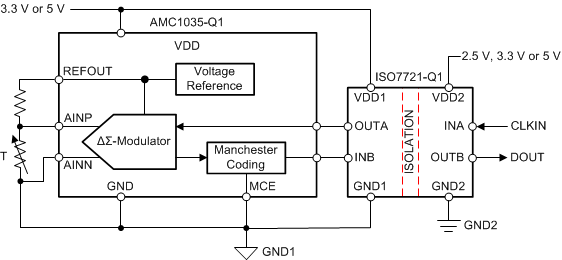-
AMC1035-Q1 Delta-Sigma Modulator With a Bipolar Input of ±1 V and Reference Output of 2.5 V
- 1 Features
- 2 Applications
- 3 Description
- 4 Revision History
- 5 Pin Configuration and Functions
- 6 Specifications
- 7 Detailed Description
- 8 Application and Implementation
- 9 Power Supply Recommendations
- 10Layout
- 11Device and Documentation Support
- 12Mechanical, Packaging, and Orderable Information
- IMPORTANT NOTICE
AMC1035-Q1 Delta-Sigma Modulator With a Bipolar Input of ±1 V and Reference Output of 2.5 V
1 Features
- AEC-Q100 qualified for automotive applications:
- Temperature grade 1: –40°C to +125°C, TA
- Delta-sigma modulator optimized for voltage and temperature sensing:
- Input voltage range: ±1 V
- High differential input resistance: 1.6 GΩ (typ)
- Integrated 2.5-V, ±5-mA reference for ratiometric measurement
- Excellent DC performance:
- Offset error: ±0.5 mV (max)
- Offset drift: ±6 µV/°C (max)
- Gain error: ±0.25% (max)
- Gain drift: ±45 ppm/°C (max)
- Ratiometric gain drift: ±15 ppm/°C (max)
- Selectable Manchester encoded or uncoded bitstream output
2 Applications
- Voltage and temperature sensing in:
- Traction inverters
- Onboard chargers
- DC/DC converters
- Integrated power modules
3 Description
The AMC1035-Q1 is a precision, delta-sigma (ΔΣ) modulator that operates from a single 3.0-V to 5.5-V supply and with an externally supplied clock signal in the range of 9 MHz to 21 MHz. In Manchester mode, the specified clock range is 9 MHz to 11 MHz. The differential ±1-V input structure of the device is optimized for voltage and temperature sensing applications.
Select the output bitstream of the AMC1035-Q1 to be Manchester coded to prevent setup and hold time requirement considerations of the receiving device and to reduce overall circuit layout efforts. When used with a digital filter (such as integrated in the TMS320F28004x, TMS320F2807x, or TMS320F2837x microcontroller families) to decimate the output bitstream, the device can achieve 16 bits of resolution with a dynamic range of 87 dB at a data rate of 82 kSPS.
The internal reference source of the AMC1035-Q1 supports a ratiometric circuit architecture to minimize the negative impact of the supply voltage variation and temperature drift on the accuracy of the measurement.
The AMC1035-Q1 can also be used for high common-mode AC voltage sensing with a digital isolator and isolated power supply.
Device Information(1)
| PART NUMBER | PACKAGE | BODY SIZE (NOM) |
|---|---|---|
| AMC1035-Q1 | SOIC (8) | 4.90 mm × 3.90 mm |
- For all available packages, see the orderable addendum at the end of the datasheet.
Device Images
Application Example
